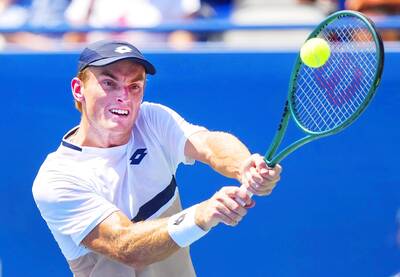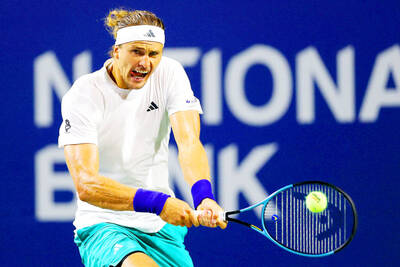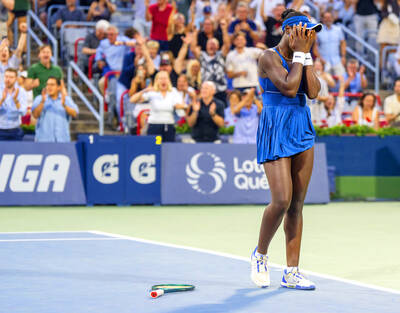To the untrained eye, arnis — the stick-wielding martial art of the Philippines — is brutal and frenzied, but behind the chaos lies a tradition dating back hundreds of years. With some contests lasting just a few minutes, the fast and furious combat sport made a triumphant return to the Southeast Asian Games this week, boosting the home nation’s haul of golds by 14.
Filipino arnisadors are fiercely proud of their country and of the sport that symbolizes their spirit of battle and revolution.
The martial art holds a treasured place in Filipino hearts as it evokes 16th-century tribal ruler Lapu-Lapu, whose army killed Ferdinand Magellan, the lead explorer in the first successful circumnavigation of the globe, and saw off the Spanish invaders, delaying their colonization by several decades.

Photo: AFP
“We consider this the martial art of Lapu-Lapu,” said Philippine Senator Miguel Zubiri, who is president of the Philippines Arnis Federation.
“Lapu-Lapu was our first defender,” the former world champion added at the Angeles University Foundation, about 80km northwest of Manila. “We consider him our first national hero. He is actually in our logo and we consider him as our founding father.”
The “full combat” version of arnis is rapid and unforgiving, and the weapons are considered as extensions of the body.
“It’s a style of fighting where you utilize knives and sticks,” Zubiri said, adding that the Spanish banned bladed weapons during their occupation, so Filipinos instead trained with sticks.
Players in body armor and grilled helmets bow to one another in the middle of the fighting square before attempting to strike their opponent’s body with a baton made of rattan.
At the SEA Games, men and women from just four nations — the Philippines, Myanmar, Cambodia and Vietnam — fought in bantamweight, featherweight, lightweight and welterweight divisions.
They also performed solo choreographed routines with weapons, known as anyo, for which competitors wore traditional costumes.
Crisamuel Delfin won a gold medal for his “open weapon” routine, during which he wielded a sword, and performed somersaults and flips.
His feathered headdress is a sign of ferocity, painted tattoos show a warrior’s accomplishments and place in society, and the pattern on his wanno loincloth indicates where he is from — the mountainous region of Ifugao, Delfin said.
“Being from the tribes of the northern provinces, it was very important that I was able to show my traditional costume and to revive and rekindle the spirit of being a warrior in the Philippines,” he said through a translator. “I was glad I was to bring out not just the movements, but the emotion and the feeling of being fierce and committed — the spirit of being a martial artist.”
Abegail Abad, from Baguio City in Luzon, won the women’s welterweight padded stick competition.
“For me it is important to look back for the traditional, because it is what binds us together,” she said. “And if this binds us together, we can also be what we want to be in the future.”
Arnis was last included as a competition in the SEA Games in 2005, when the Philippines last hosted the event — and when they last finished at the top of the medals table.
They are on course to repeat the feat, as the SEA Games’ program is flexible and events can be included in the hosts’ favor.

TAIWANESE EXITS: Fellow Australian Christopher O’Connell joined Tristan Schoolkate as a winner following his 6-1, 6-2 defeat of Tseng Hsin-chun Australian qualifier Tristan Schoolkate on Monday dispatched rising Brazilian talent Joao Fonseca 7-6 (7/5), 6-4 at the ATP Toronto Masters, ensuring a breakthrough into the world top 100. The 24-year-old from Perth moved to 98th in the ongoing live rankings as he claimed his biggest career victory by knocking out the ATP NextGen champion from November last year. Schoolkate, son of a tennis coach, won his first match over a top-50 opponent on his sixth attempt as he ousted the world No. 49 teenager from Brazil. The qualifier played a quarter-final this month in Los Cabos and won through qualifying for his

Top seeds Alexander Zverev of Germany and American Coco Gauff on Tuesday advanced to the third round of the Canadian Open after both players were pushed hard by their opponents. World No. 3 Zverev, playing in his first match since his first-round loss at Wimbledon, was far from his best, but emerged with a 7-6 (8/6), 6-4 win over Adam Walton under the lights in Toronto. Momentum shifted firmly in Zverev’s favor when he won a 52-shot rally in the first set tiebreak and he sealed the win on a double fault by the Australian in the second set. “It was a very

Canadian teenager Victoria Mboko upset top-seeded Coco Gauff 6-1, 6-4 on Saturday night to reach the National Bank Open quarter-finals. “Your support was incredible,” Mboko told the crowd in French after a chorus of “Ole, Ole, Ole” chants echoed around the venue. “I’m really happy to win today ... It’s incredible. I’m so happy to beat such a great champion.” Gauff dropped to 2-3 since winning the French Open. She followed the major victory with opening losses in Berlin and Wimbledon, then overcame double-fault problems to win two three-set matches in Montreal. Gauff had five double-faults on Saturday after having 23 in

Formula 1 champion Max Verstappen on Thursday said that he is staying with the Red Bull team next year, ending months of speculation over his future. “Some people just like to stir the pot, some people just like to create drama, but, for me, it’s always been quite clear, and also for next year,” the four-time champion said ahead of the Hungarian Grand Prix. “I’m discussing with the team already the plans — the things that we want to change for next year, so that means that I’m also staying with the team for next year,” he said. Verstappen has a contract with